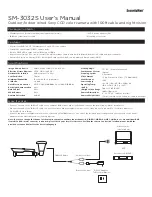
Add-on Camera
WVS1000
User manual
At the end of the product lifecycle, you should not
dispose of this product with normal household waste, but
take the product to a collection point for the recycling of
electrical and electronic equipment. The symbol on the
product, user’s guide and/or box indicates this.
Some of the product materials can be re-used if you take
them to a recycling point. By reusing some parts or raw materials from
used products you make an important contribution to the protection of
the environment.
Please contact your local authorities in case you need more information
on the collection points in your area.
Dispose of the battery pack in an environmentally-friendly manner
Disposal of the device (Environment)
FCC and IC regulations
FCC Part 15
NOTE: This equipment has been tested and found to comply with the
limits for a Class B digital device, pursuant to Part 15 of the Federal
Communications Commission (FCC) rules. These limits are designed to
provide reasonable protection against harmful interference in a
residential installation. This equipment generates, uses and can radiate
radio frequency energy and, if not installed and used in accordance with
the instructions, may cause harmful interference to radio
communications. However, there is no guarantee that interference will
not occur in a particular installation. If this equipment does cause harmful
interference to radio or television reception, which can be determined by
the interference by one or more of the following measures:
Reorient or relocate the receiving antenna.
Increase the separation between the equipment and receiver.
to which the receiver is connected.
Consult the dealer or an experienced radio/TV technician for help.
the party responsible for compliance could void the user’s authority to
operate the equipment.
This device complies with Part 15 of the FCC rules. Operation is subject
to the following two conditions: (1) this device may not cause harmful
interference, and (2) this device must accept any interference received,
including interference that may cause undesired operation. Privacy of
communications may not be ensured when using this device.
To ensure safety of users, the FCC has established criteria for the amount
of radio frequency energy that can be safely absorbed by a user or
bystander according to the intended usage of the product. This product has
been tested and found to comply with the FCC criteria. The Baby unit shall
be installed and used such that parts of the user’s body other than the hands
are maintained at a distance of approximately 20 cm (8 inches) or more.
This Class B digital apparatus complies with Canadian ICES-003.
WARNING
by the party responsible for compliance could void the user’s authority
to operate the equipment.
Industry Canada
Operation is subject to the following two conditions: (1) this device may not
cause harmful interference, and (2) this device must accept any
interference, including interference that may cause undesired operation of
the device.
RENSEIGNEMENTS RELATIFS AUX RÈGLEMENTS DE
LA COMMISSION FÉDÉRALE DES COMMUNICATIONS
’FCC’, ET D’INDUSTRIE Canada ’IC’
Article 15 des règlements du FCC
AVIS
:
Cet équipement a été testé et s’est révelé conforme aux limites d’un
appareil numérique de classe B, conformément à la Section 15 du
réglement de la Federal Communications Commission (FCC). Ces limites
interférence nuisible sur une installation résidentielle. Cet appareil génère,
utilise et peut émettre des fréquences radio et s’il n’est pas installé selon
les instructions, peut nuire aux radiocommunications. Toutefois, rien ne
garantit que des parasites ne surviendront pas dans une installation
particulière. Si cet appareil cause des interférences nuisibles à la réception
du téléviseur ou de la radio, ce que vous pouvez déterminer en mettant
votre appareil en et hors fonction, nous vous invitons à essayer l’une des
mesures correctives suivantes :
- Réorientez l’antenne de réception.
- Éloignez l’appareil du composant qui reçoit les ondes.
du composant qui reçoit les ondes.
- Au besoin, consultez votre marchand électronique ou un technicien
spécialisé dans le service des radios/téléviseurs pour des
suggestions supplémentaires.
des parties responsables de l’homologation peut retirer à l’utilisateur
son droit d’utiliser l’appareil.
Cet appareil est conforme à l’article 15 de la FCC. Le fonctionnement
est soumis aux deux conditions suivantes: (1) Cet appareil ne doit pas
causer d’interférences nuisibles et; (2) Il doit pouvoir supporter les
parasites qu’il reçoit, incluant les parasites pouvant nuire à son
être assurée avec cet appareil.
relatifs à l’énergie générée par les fréquences radio pouvant être
absorbée en toute sécurité par un utilisateur ou par quelqu’un se
trouvant à proximité, dépendamment de l’utilisation prévue du produit.
Ce produit a été testé et s’avère conforme aux normes de la FCC.
L’unité du bébé devra être installée et utilisée de manière à ce que le
corps de l’utilisateur, à l’exception des mains, soit toujours à une
distance d’environ 20 cm (8 po.) ou plus.
Cet appareil numérique de la classe B est conforme à la norme NMB-003
du Canada.
AVERTISSEMENT
autorisé par la partie responsable de la conformité, pourrait annuler
l’autorisation donnée à l’utilisateur d’utiliser cet équipement.
Industrie Canada
Le fonctionnement est soumis aux deux conditions suivantes : (1) Cet
appareil ne doit pas causer d’interférences nuisibles et; (2) Cet appareil
accepte toute les interférences dont celles qui pourraient provoquer le
fonctionnement involontaire de l’appareil.
que les normes d’Industrie Canada ont été rencontrées.
Canada.
Changes or modifications to this equipment not expressly approved by
the party responsible for compliance could void the user’s authorthority to
operate the equipment.


































